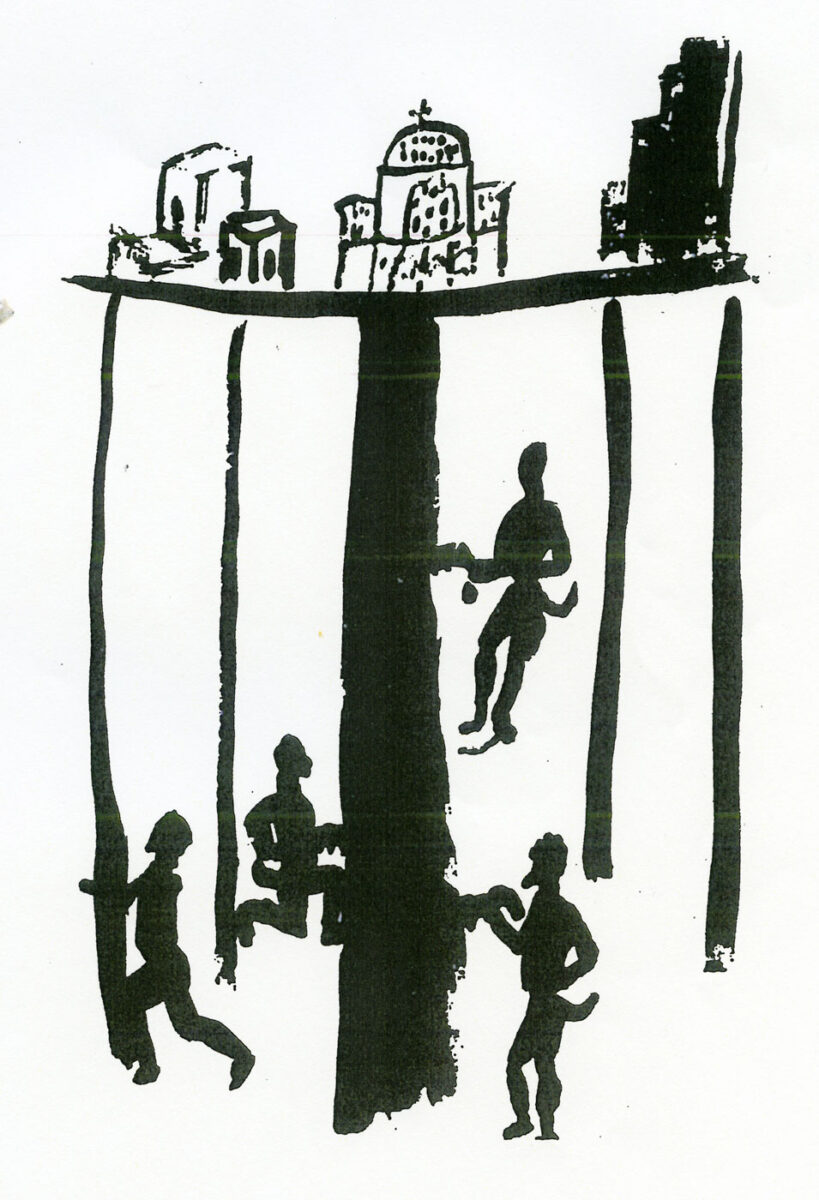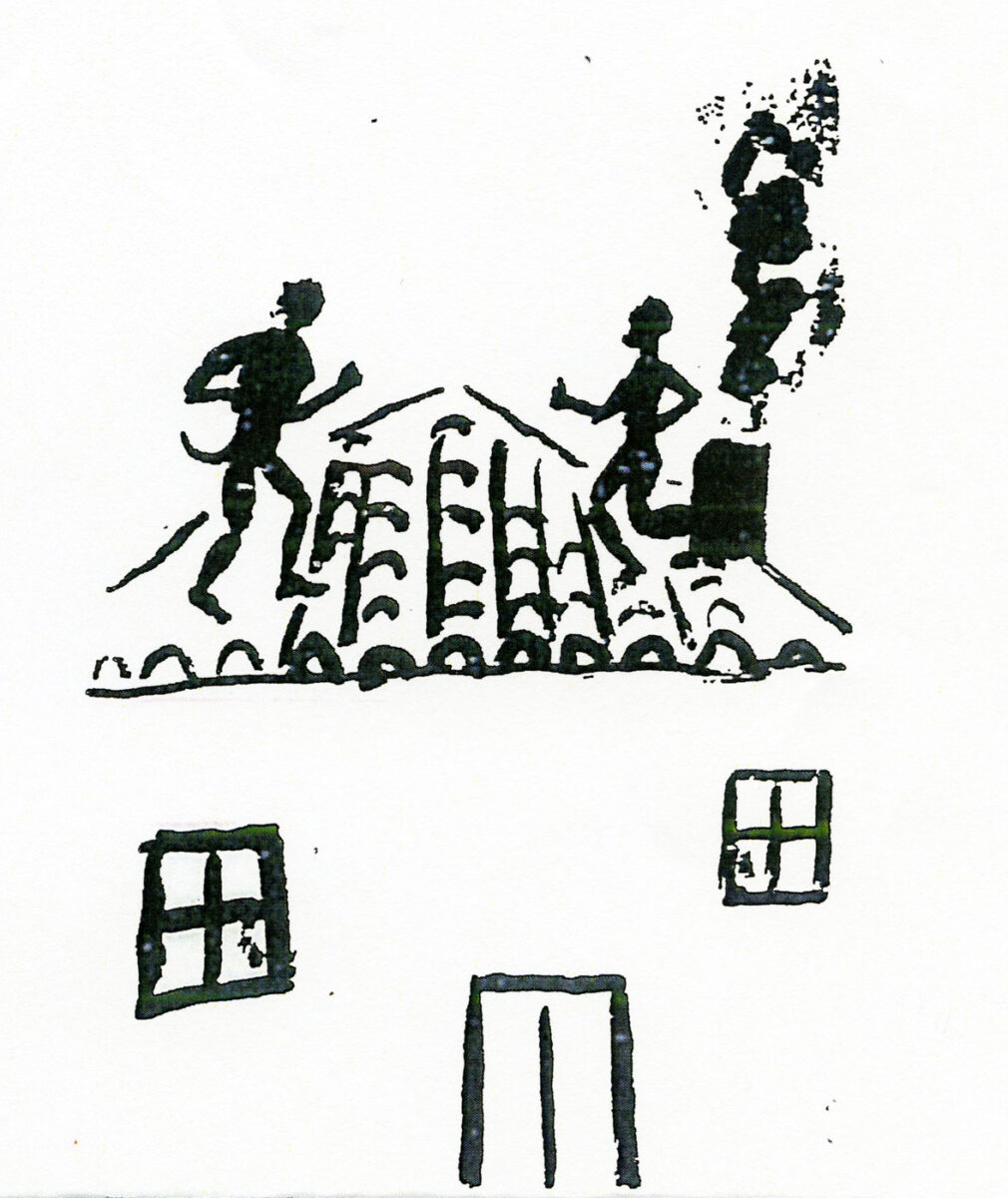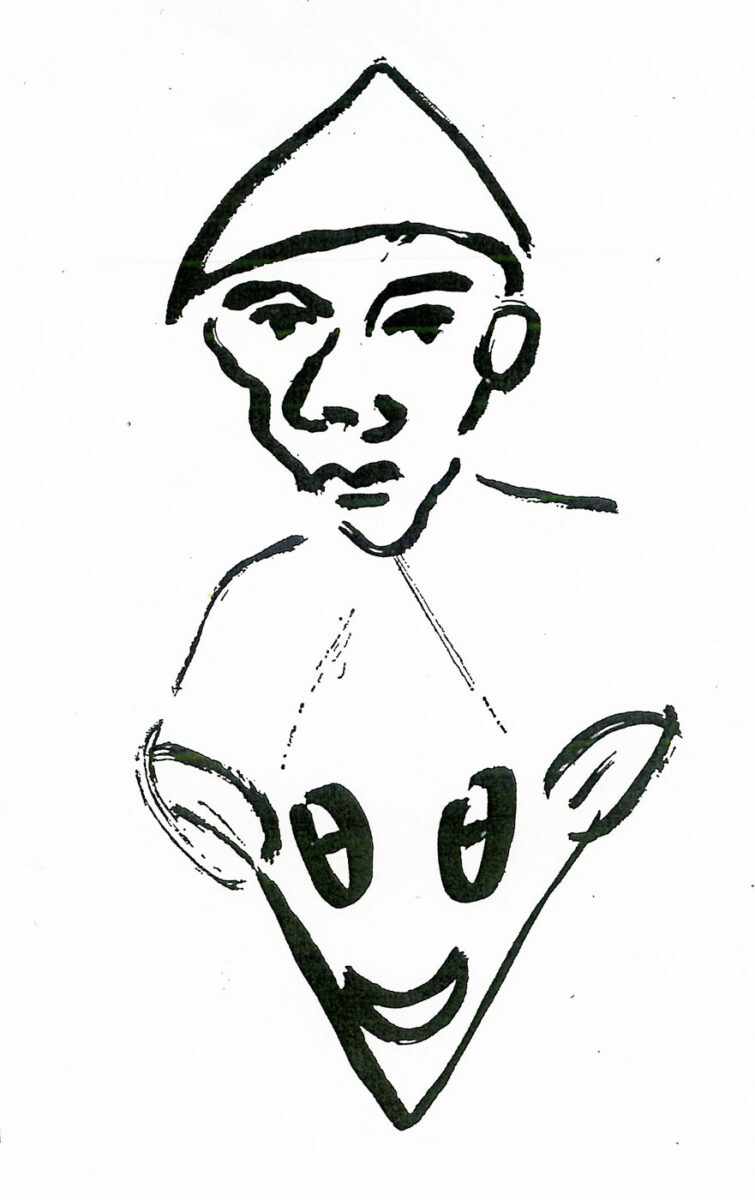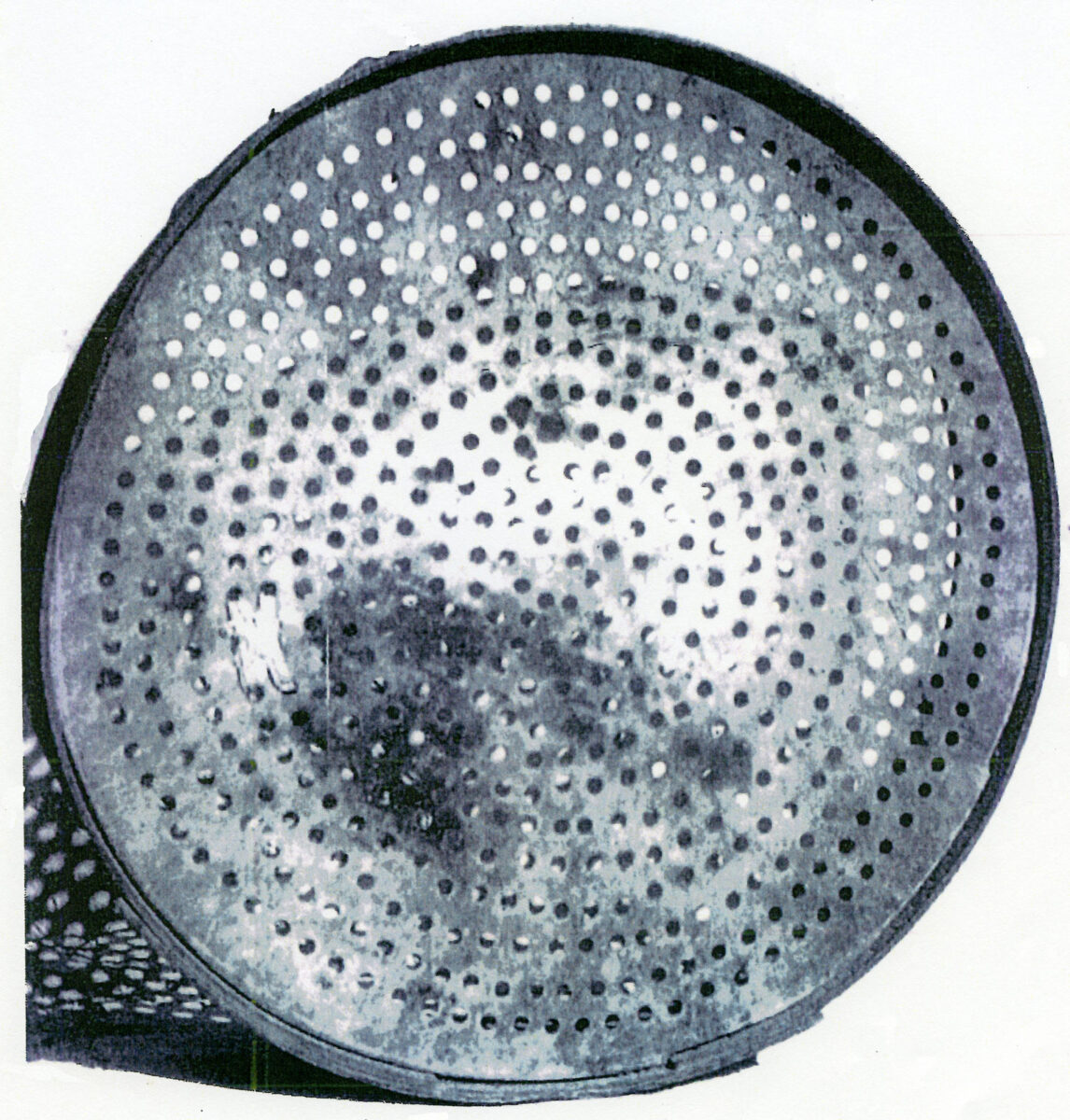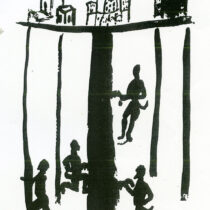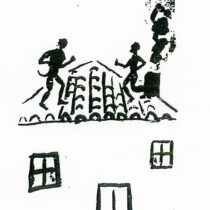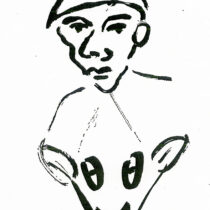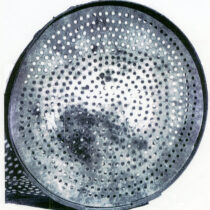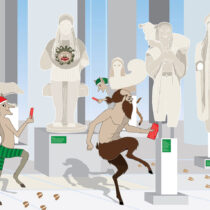In memory of my grandmother Athena who used to tell me stories as a child about Goblins and Imps
“The Twelve days”, a well known term used in folklore, refers to the period between Christmas Eve and Epiphany.
The concept of the “Twelve days (Δωδεκαήμερο)” is linked to time and superstition and was known and used by the Greeks since the Byzantine era and also by other Christian peoples of Europe from the Middle Ages; les Douze jours, i Dodici giorni, et al.
According to popular belief, at this time of year evil spirits are seen roaming the earth, forcing humans to stay at home, especially at night, gathered round the protective fire (note 1) of the family hearth which they worship almost like pagans
The Twelve day period is thought to be dangerous because Goblins circulate on earth during the nights that are the longest of the year.
Goblins are happy, naughty demons that temporarily left their home in the depths of the earth and climbed to its surface to tease the humans.
Throughout the Twelve Days, the fire that keeps the Goblins away burns night and day in the family hearth. The master of the house has chosen a thick wooden stick cut from a thorny tree popularly believed to get rid of demons. This wood is called either Christ’s wood (Χριστόξυλο), Dodekameriti or Skarkantzalo.
The piece of Christ’s wood will burn day and night all through the Twelve days. Before being thrown on the fire, it is sprinkled with dried fruits (καταχύσματα).
In many parts of Greece, two or three pieces of wood are put together, making up the “marriage of the fire”. One is from an upright male tree, such as the cedar, that symbolizes the master of the house, the second is from a female tree with off shoots like the wild cherry or pear tree symbolizing the mistress of the house and the third stands for the best man, a necessary person at every wedding.
On the island of Lefkada, the master of the house throws oil and wine onto the wood mentioned above, rather like making a libation. In other parts of Greece, plants, such as asparagus, are thrown onto the fire, making a loud noise as they burn. The noises and smoke are popularly believed to scare off snakes and demons.
The pieces of wood left over from the Twelve days fire are stuck into the soil by the peasants for the corn to flourish. The ashes are scattered into the four corners of the house, as well as the courtyards, stables, orchards and gardens to drive all evil far away.
In northern Greece, formerly in the Pontus region and other places, great fires are lit in the squares or at the highest points of villages and small towns. Οld and young sing round the fire, ringing bells at the same time. In this way they believe that with the fire and the sound of bells they will keep away the demons of the Twelve days. For the same reason, in earlier times passersby were obliged to go out at night holding a lighted torch.
The custom of masquerading as observed in northern Greece, Macedonia, Thrace and Thessaly seems to have some connection with the Goblins. Those wearing disguise are called Rogatsia ,Rogatsaria or Momogeroi and cover themselves in the skins of wolves, billy goats, and bears. They tour the village neighborhoods, go into houses, sing and collect gifts.
It has been argued that these disguises are a symbol of winter and also of the souls of the dead who come from the Underworld this time of year and disturb the living. , Both during the Byzantine era and in times following the Fall of Constantinople, those in disguise frightened people and especially children with their antics and this is why popular imagination gave them the form of Goblins.
According to another theory, Goblins were created because of the fear the living feel for the dead. In popular worship, during the Twelve day period, the dead ascend to the Upper World and disturb the living without however causing them any special harm.
In Cephalonia, as in other Ionian islands, these demonic creatures are called Pagana. The word is related to Paganism and the popular worship of the ancient Greeks.
Both for us and other European peoples, goblins, werewolves, dragons and witches are primarily creatures of the night and the countryside.
Generally these beliefs originate from Roman customs of worship around the paths of the sun in winter, when the people observed the festivals of Saturnalia, Kalendae, Vota et al.
People then believed that the powers of winter and darkness did not want to submit to the “invincible Sun”. The sun’s enemy was the darkness. The beings symbolizing the darkness who live all the year round in the depths of the earth and hate the Sun are the Goblins of our folk tradition.
Throughout the year, the Goblins gnaw the gigantic tree that supports the earth. When only a thread remains for the tree to fall and the world destroyed, Christmas Eve arrives and the Goblins ascend to the earth where they remain till the Eve of Epiphany.
While the Goblins are roaming the Upper World, the tree becomes whole once again. This tree is the sun that invigorates nature in which we live. After the winter solstice, darkness recedes and light is victorious. Light stands for life, hope and joy.
In their legends, almost all the peoples on earth imagine the Sun fighting the forces of winter and its accompanying darkness and coming out victorious.
The Christian Church chose the same days as prominent landmarks for observing its own celebrations of Christmas, Saint Basil (New Year) and Epiphany. The people adapted to the new spirit of the celebrations, waiting to free itself from the “evil” of the Twelve days with the birth of Christ and the blessing of the Waters.
Most of the popular customs found during the Twelve days express, in one way or another, the concept of ending and beginning. They are, so to speak, rites of passage customs (note 2) expressing man’s agony when confronting the end of one period of his life, a year on its way out and the start of a new one or the transition from winter to the coming of spring.
The most interesting arguments related to the origin of Goblins are the following:
A) The theory of N.G. Politis and F. Koukoules that the Goblins were remnants in popular memory of people in Byzantine times masquerading during the Twelve days of Christmas, who wandered freely in the streets, behaving improperly and teasing passersby.
Β) The view held by K.Romaios and other scholars of folklore that the Goblins were symbols of demons of the underworld (Νεκυδαίμονες), who came up from Hades during the Sun’s winter trajectories. This version is supported by popular beliefs of the inhabitants of Farasa in Cappadocia concerning the dead (note 3). The Farasiotes believed that, during the Twelve days, the dead returned to the Upper World, wandered the streets at night and entered houses by the chimneys. The Farasiotes burnt incense in their fireplace to get rid of the dead.
Thus the demons of the Twelve days, the Goblins, are none other than the Kires (Κήρες) i.e. spirits living in Hades. During the festival of Anthesteria when the ancient Athenians believed that Hades was open, the spirits returned to the Upper World and bothered humans in different ways.
Of course, the Athenians took various precautions, such as wrapping red thread round their sanctuaries, creating in this way a magic circle which the spirits could not cross. They also smeared the doors of their houses and temples with tar and chewed all day on a thorny bush called the Ramnos (note 4), to prevent spirits entering their temples, houses and bodies.
The Romans believed that dead ancestors visited their relatives at home. There were similar believes among medieval peoples of Europe such as the Prussians, Normans, Irish and Scandinavians. The latter in particular believed that the dead returned to their old dwelling places and so they prepared them a bed and food.
As Martin P. Nilsson writes: “Popular habits in all countries and times are related” (note 5).
Fear of Goblins dictated to the locals of mainly rural Greece some methods for keeping them away. The lower jaw of a pig was hung as a deterrent behind the house’s door or in the chimney.
Either salt or an old shoe or both were burnt on the fire, because locals believed that the sound made by the salt and the stench of the burning shoe kept the Goblins away. Another way of fooling them was by tying a ball of flax on the door handle. By the time the Imp had disentangled and counted the flax’s fibres, time had passed and the dawn cock had crowed, announcing the day which drives all night demons far away.
In Cephalonia in the old days, on the night of Christmas Eve when the fire was lit for the Twelve days, the locals marked the sign of the cross on their houses’ doors and windows with a piece of coal or lighted torch. This was done so the Goblins would not dare enter their homes. Old housewives would also place a sieve in the chimney’s opening.
The Ιmps (Pagana) would try to count the holes in the sieve, known on the island of Kimolos as an “alargos” (note 6), they got muddled as time passed, then the cock crowed and the imps vanished. Millers in the Cyclades, who also had a hard time with the Goblins’ pranks, used the same trick to keep them busy.
The resourceful housewife made sure not to leave utensils, pots, clothes or small items of furniture outside the house on the nights of the Twelve days, for them not to be infected by the Imps.
Man’s primeval fear of the winter and its darkness is hidden behind these superstitions, whether historical or metaphysical. This is why, as Dimitris Loukatos writes, the Cephalonian housewife chants the following words, like a wish or a spell, when marking the doors and windows of her house with a cross:
“Christ is born,
light increases,
and dark decreases”
As light increases with the lengthening of the day, so does hope for vegetation, the coming spring and production of livestock and crops anticipated by the farming world.
According to popular belief, between Christmas and the Epiphany when Christ is not baptized, neither are the waters. During this time the Goblins (note 7) wander round the streets, countryside, mills, threshing floors and enter houses by the chimneys, making a mess of whatever they find and mainly infecting the food of humans.
The names given to them by the people vary from place to place. We are informed by Michael Psellus (1018-1078) that the Byzantines called the Goblins “Nightmares (Βαβουτσικάριους)”, in Farasa, Cappadocia they were called Mnemorati, Planetaroi in Cyprus, Kallivrousides in Andros, Kolovelonides in Athens, Lykokantzara in Trifyllia, Pagana in Cephalonia ,but also Tsilikrota, Kaliotzides,Parorites, Kapsiourides et al.
There is no limit to popular imagination when it comes to the appearance of Goblins. Some believe they are like humans but with black complexions, very tall, ugly, dressed in rags and wearing iron shoes. Others picture them black, resembling devils, red eyed, with the legs either of a goat or donkey, monkey paws and a hairy body. Others imagine them as lame, blind, with only one arm or leg, one eyed and very stupid. Whatever appearance they have, Goblins eat snakes, worms, frogs, lizards, but they also like fritters and sausages.
In Anchialos, three days before Christmas, on December 22nd the name day of St Anastasia Farmakolytria, sweets made of wheat, raisins, walnuts, various dried fruits, sugar and a little flour are distributed among the houses. Before sharing out these sweets, three spoonfuls would be thrown under the chimney to entice the Goblins.
In Cyprus, on the last of the Twelve days, when the Planetaroi are departing, fritters are prepared and thrown on the roof tops for them to eat.
In Modern Greek popular worship, it is believed that the roof of the house is where demons gather, whether they are benevolent or malevolent, but none the less dangerous for the tenants.
The Pagana enter the houses by the chimney, ride on the shoulders of passersby and make them dance. The night gatherings of Goblins (note 8) take place in the country, at crossroads, remote mills, threshing floors or under bridges.
The people believe that children born on Christmas day turn into Goblins. To prevent this from happening, the child was tied to its mother’s hand with a straw rope or braided garlic. In that way, it was thought that it could not leave with the Goblins. Sometimes the child’s toenails were burnt, because without them it could not become a Goblin.
The last of the Twelve days is the “First Blessing (Πρωταγίαση)”, meaning the First Blessing of the Epiphany that takes place in church, on the eve of the festival. Afterwards the priest goes from house to house with the Cross and a sprig of basil in one hand, sprinkling the holy water in every room. The “First Blessing” is taken by the locals to their fields and the village fountains to drive away the Goblins that defile whatever they encounter.
This last of the Twelve days is the final day of the Goblins’ stay on earth. They flee in a panic chased by the priest’s holy sprinkling device (αγιαστούρα), saying among themselves:
“You must get out, let’s all get out
‘cause the crazy priest has come
with his blessing thing
and his sprinkling thing
rum ti tum ti tum!!”
Leaving the Upper World, the Goblins return deep underground where they recommence sawing at the tree that holds up the earth. Although it had been abandoned when almost cut down, the tree has grown back again in the meantime,.
Afendra G. Moutzali
Archaeologist
GLOSSARY
Alargos (m): Sieve used to keep the Goblins busy. Alarga: adverb meaning in the open seas and generally far away. The devil is sometimes called “The one who is alarga and far from here (Ο αλάργα και Όξω από δω)”
Kalik-antza-ros (m) :The one who wears the kalikion (a type of shoe) on his antza ( foot) and the ending –ros to exaggerate size such as in the name Mimis /Mimaros and child; paidi/paidaros
Magarizo: I infect. It was believed that the Goblins pissed on the food, utensils and clothes of humans.
Ramnos (f): a thorny hedge.
Skouli (n):a ball of thread, tuft of hair or flax.
